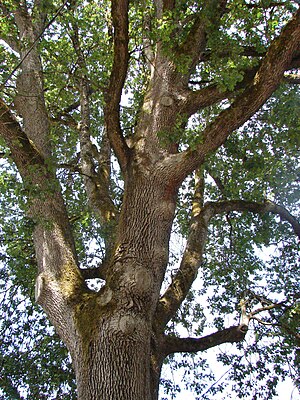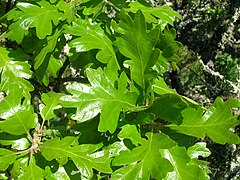Oregon oak
| Oregon oak | ||||||||||||
|---|---|---|---|---|---|---|---|---|---|---|---|---|

Oregon oak ( Quercus garryana ) |
||||||||||||
| Systematics | ||||||||||||
|
||||||||||||
| Scientific name | ||||||||||||
| Quercus garryana | ||||||||||||
| Douglas ex Hook. |
The Oregon oak ( Quercus garryana ), also known as Garry Oak , is a deciduous tree from the genus of oaks in the beech family . The distribution area is in North America.
description
The Oregon oak is a deciduous 15 to rarely 20 meter high tree with a single trunk or 1 to 3 meter high shrub . The bark is light gray or almost white and scaly. The branches are brown, red, or yellowish, 2 to 4 millimeters in diameter, densely downy-haired or glabrous. The buds are 2 to 12 millimeters long, brown or yellowish, ovate to spindle-shaped, pointed, and hairy glandular or downy. The leaves are simple and have a 4 to 10 millimeter long petiole. The leaf blade is 25 to 120, rarely 140 millimeters long and 15 to 85 millimeters wide, obovate, elliptical or rounded, with three to five lobes slightly indented on both sides, with a rounded or wedge-shaped, rarely heart-shaped base and blunt tip. The upper side of the leaf is light to dark green and sparsely covered with star hairs, the underside is light green or yellowish pruned and sparsely to densely covered with 0.1 to 1 millimeter long hairs. Four to seven yellowish pairs of nerves are formed.
The acorns stand individually or in groups of up to three. They are almost sitting or rarely stand on 10 to 20 millimeter long stems. The fruit cup is cup-shaped to hemispherical, 4 to 10 millimeters deep, 12 to 22 millimeters in diameter and yellowish or reddish brown scales. The acorns are light brown, elongated to round, 25 to 30 (rarely from 12 to 40) millimeters long and 14 to 20 (rarely 10 to 22) millimeters in diameter, bald or downy-haired. The number of chromosomes is .
Distribution and ecology
The natural range is in British Columbia in western Canada and in Oregon , Washington and California in the United States. The species grows in summer-dry mountain areas, shielded from the Pacific winds by upstream mountains up to 1200 meters in the border area between forest and steppe on stony, shallow and poor soils . They are often found together with Douglas firs .
Systematics and research history
The Oregon oak ( Quercus garryana ) is a species from the genus of oaks ( Quercus ) in the beech family (Fagaceae). The first valid description was in 1840 by William Jackson Hooker .
There are three varieties :
- Quercus garryana var. Breweri (Engelmann) Jepson
- Quercus garryana var. Garryana
- Quercus garryana var. Semota Jepson
use
The Oregon oak is arguably the economically most important oak in Pacific North America, but it is little used due to the rough terrain.
proof
literature
- Flora of North America Editorial Committee (Ed.): Flora of North America North of Mexico . Volume 3: Magnoliophyta: Magnoliidae and Hamamelidae . Oxford University Press, New York / Oxford a. a. 1997, ISBN 0-19-511246-6 , pp. 508 (English).
- Schütt, Schuck, Stimm: Lexicon of tree and shrub species . Nikol, Hamburg 2002, ISBN 3-933203-53-8 , pp. 428 .
Individual evidence
- ^ German name after Schütt et al .: Lexicon of tree and shrub species
- ↑ a b c Schütt et al .: Lexicon of Tree and Shrub Species , p. 428
- ↑ a b c d Kevin C. Nixon: Quercus garryana in Flora of North America , Volume 3
- ↑ a b Quercus garryana. In: Germplasm Resources Information Network (GRIN). United States Department of Agriculture, accessed February 18, 2012 .
Web links
- Quercus garryana. In: The Plant List. Retrieved February 18, 2012 .



